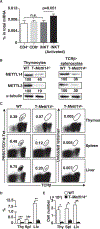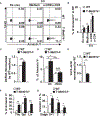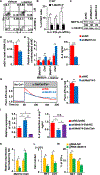METTL14-dependent m6A modification controls iNKT cell development and function
- PMID: 35926466
- PMCID: PMC9495716
- DOI: 10.1016/j.celrep.2022.111156
METTL14-dependent m6A modification controls iNKT cell development and function
Abstract
N6-methyladenosine (m6A), the most common form of RNA modification, controls CD4+ T cell homeostasis by targeting the IL-7/STAT5/SOCS signaling pathways. The role of m6A modification in unconventional T cell development remains unknown. Using mice with T cell-specific deletion of RNA methyltransferase METTL14 (T-Mettl14-/-), we demonstrate that m6A modification is indispensable for iNKT cell homeostasis. Loss of METTL14-dependent m6A modification leads to the upregulation of apoptosis in double-positive thymocytes, which in turn decreases Vα14-Jα18 gene rearrangements, resulting in drastic reduction of iNKT numbers in the thymus and periphery. Residual T-Mettl14-/- iNKT cells exhibit increased apoptosis, impaired maturation, and decreased responsiveness to IL-2/IL-15 and TCR stimulation. Furthermore, METTL14 knockdown in mature iNKT cells diminishes their cytokine production, correlating with increased Cish expression and decreased TCR signaling. Collectively, our study highlights a critical role for METTL14-dependent-m6A modification in iNKT cell development and function.
Keywords: CD1; CP: Immunology; CP: Molecular biology; NKT cells; T cell development; knockout mice; m(6)A.
Copyright © 2022 The Authors. Published by Elsevier Inc. All rights reserved.
Conflict of interest statement
Declaration of interests H.H. is an employee of Genentech.
Figures







Similar articles
-
Mettl3-m6A-Creb1 forms an intrinsic regulatory axis in maintaining iNKT cell pool and functional differentiation.Cell Rep. 2023 Jun 27;42(6):112584. doi: 10.1016/j.celrep.2023.112584. Epub 2023 Jun 1. Cell Rep. 2023. PMID: 37267102
-
Transcription factor YY1 is essential for iNKT cell development.Cell Mol Immunol. 2019 Jun;16(6):547-556. doi: 10.1038/s41423-018-0002-6. Epub 2018 Mar 2. Cell Mol Immunol. 2019. PMID: 29500401 Free PMC article.
-
Kidins220 and Aiolos promote thymic iNKT cell development by reducing TCR signals.Sci Adv. 2024 Mar 15;10(11):eadj2802. doi: 10.1126/sciadv.adj2802. Epub 2024 Mar 15. Sci Adv. 2024. PMID: 38489359 Free PMC article.
-
New Genetically Manipulated Mice Provide Insights Into the Development and Physiological Functions of Invariant Natural Killer T Cells.Front Immunol. 2018 Jun 14;9:1294. doi: 10.3389/fimmu.2018.01294. eCollection 2018. Front Immunol. 2018. PMID: 29963043 Free PMC article. Review.
-
The Role of Adaptor Proteins in the Biology of Natural Killer T (NKT) Cells.Front Immunol. 2019 Jun 25;10:1449. doi: 10.3389/fimmu.2019.01449. eCollection 2019. Front Immunol. 2019. PMID: 31293596 Free PMC article. Review.
Cited by
-
Interaction of the intestinal cytokines-JAKs-STAT3 and 5 axes with RNA N6-methyladenosine to promote chronic inflammation-induced colorectal cancer.Front Oncol. 2024 Jul 29;14:1352845. doi: 10.3389/fonc.2024.1352845. eCollection 2024. Front Oncol. 2024. PMID: 39136000 Free PMC article. Review.
-
The Role of M6A Modification in Autoimmunity: Emerging Mechanisms and Therapeutic Implications.Clin Rev Allergy Immunol. 2025 Mar 14;68(1):29. doi: 10.1007/s12016-025-09041-6. Clin Rev Allergy Immunol. 2025. PMID: 40085180 Review.
-
Linking ferroptosis to thymic involution.Nat Aging. 2024 Dec;4(12):1673-1675. doi: 10.1038/s43587-024-00777-y. Nat Aging. 2024. PMID: 39578559 No abstract available.
-
RNA Metabolism Governs Immune Function and Response.Adv Exp Med Biol. 2024;1444:145-161. doi: 10.1007/978-981-99-9781-7_10. Adv Exp Med Biol. 2024. PMID: 38467978 Review.
-
Regulation of inflammatory diseases via the control of mRNA decay.Inflamm Regen. 2024 Mar 15;44(1):14. doi: 10.1186/s41232-024-00326-5. Inflamm Regen. 2024. PMID: 38491500 Free PMC article. Review.
References
-
- Baranek T, Lebrigand K, de Amat Herbozo C, Gonzalez L, Bogard G, Dietrich C, Magnone V, Boisseau C, Jouan Y, Trottein F, et al. (2020). High dimensional single-cell analysis reveals iNKT cell developmental trajectories and effector fate decision. Cell Rep 32, 108116. 10.1016/j.celrep.2020.108116. - DOI - PubMed
Publication types
MeSH terms
Substances
Grants and funding
LinkOut - more resources
Full Text Sources
Molecular Biology Databases
Research Materials
Miscellaneous

